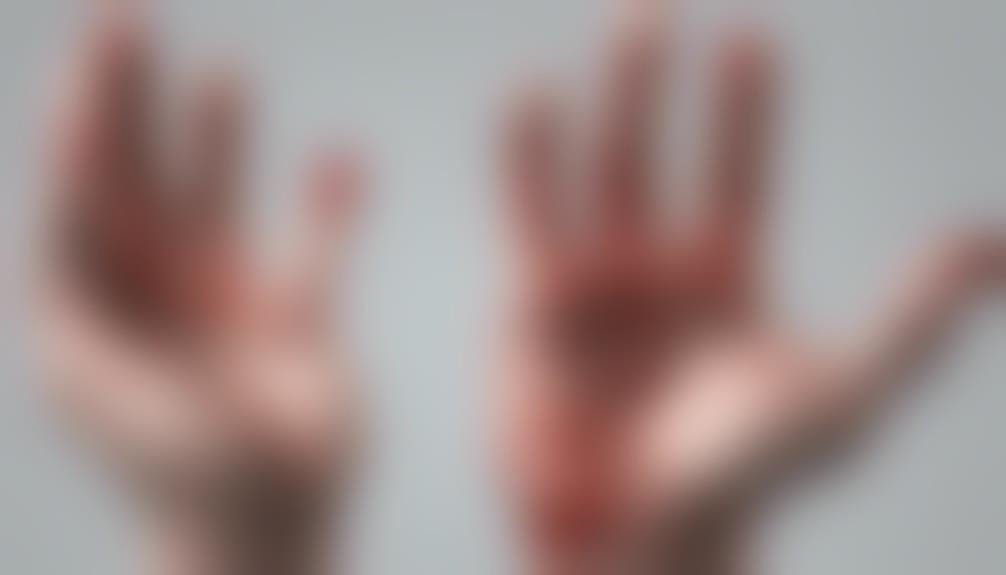Excoriation (Skin-Picking) Disorder
Excoriation Disorder, also known as Skin-Picking Disorder, involves repetitive skin-picking behavior. Factors include genetics, neurotransmitter imbalances, and stress. Coping strategies like therapy and habit reversal training help manage it. 1.4% to 5.4% of people have it. Risk factors include genetics, stress, and mental health conditions. Skin-picking causes emotional distress, anxiety, and depression. Therapy, meds, and support groups treat it. Severe skin lesions can result. Seeking early help is essential. Prevention involves therapy and awareness. Emotional distress worsens symptoms. Healthy coping is important. Complications can impact relationships and self-esteem. Seeking help early is key for effective management.
Key Takeaways
- Excoriation disorder involves repetitive, compulsive skin picking.
- Factors include genetic predisposition, neurotransmitter imbalances, and psychological stressors.
- Prevalence ranges from 1.4% to 5.4% in the general population.
- Treatment involves therapy, medication, and support groups.
- Coping mechanisms, like cognitive-behavioral therapy, are effective in managing the disorder.
Understanding Excoriation Disorder
Understanding excoriation disorder involves recognizing the repetitive, compulsive skin-picking behavior that characterizes this mental health condition. Causes and triggers of excoriation disorder vary among individuals, but common factors include genetic predisposition, neurotransmitter imbalances, and psychological stressors. Genetic studies suggest a hereditary component, indicating a potential link between family history and the development of this disorder. Additionally, imbalances in neurotransmitters such as serotonin may contribute to the urge to pick at the skin excessively.
Coping strategies and techniques play an important role in managing excoriation disorder. Cognitive-behavioral therapy (CBT) has shown effectiveness in helping individuals understand and modify their skin-picking behaviors. Furthermore, habit reversal training, a component of CBT, focuses on increasing awareness of the picking behavior and implementing competing responses to reduce the urge to pick. Relaxation techniques, mindfulness practices, and stress-reduction activities can also aid in coping with triggers that lead to skin picking episodes. Developing a personalized coping plan with the help of mental health professionals can greatly improve the management of excoriation disorder.
Prevalence and Risk Factors
Recognizing the prevalence and associated risk factors of excoriation disorder is essential for gaining a thorough understanding of this mental health condition. Prevalence data indicates that excoriation disorder affects approximately 1.4% to 5.4% of the general population, with higher rates among individuals seeking dermatological treatment.
Risk factor analysis has identified several factors that may contribute to the development or exacerbation of excoriation disorder. These factors include genetic predisposition, environmental stressors, history of trauma or abuse, comorbid mental health disorders such as anxiety or depression, and certain personality traits like perfectionism or impulsivity.
Understanding the prevalence of excoriation disorder helps healthcare providers and researchers allocate appropriate resources for diagnosis, treatment, and prevention efforts. Risk factor analysis enables clinicians to identify individuals who may be at a higher risk of developing excoriation disorder and to tailor interventions to address these specific factors.
Signs and Symptoms to Look for
You may notice warning signs such as constant picking or scratching and visible symptoms like skin lesions or scabs.
These signs and symptoms can vary in intensity and may impact your daily functioning.
If you observe these behaviors persisting, it's important to seek professional help for a proper evaluation and treatment plan.
Warning Signs to Watch
What're the key warning signs that should be monitored for individuals with Excoriation Disorder?
Early intervention is vital in managing this condition effectively. It's crucial to watch for behaviors such as recurrent skin picking leading to skin lesions, spending significant time picking skin to the detriment of daily activities, and experiencing distress or impairment due to skin picking.
Prevention strategies involve recognizing triggers and implementing behavioral therapy techniques. Additionally, practicing self-care activities like stress-reduction techniques and maintaining a structured routine can be beneficial.
Monitoring for these warning signs can help in identifying Excoriation Disorder early and seeking appropriate interventions to improve the individual's quality of life.
Common Visible Symptoms
To identify Excoriation Disorder, observe common visible symptoms such as skin lesions resulting from recurrent skin picking. These lesions may vary in severity, ranging from mild abrasions to deep wounds, often located on easily accessible areas like the face, arms, and hands.
The skin may appear red, inflamed, or infected due to continuous picking. In some cases, scarring and pigmentation changes can also be noticeable. Individuals with Excoriation Disorder may exhibit signs of distress or anxiety related to their skin-picking behavior.
Prompt recognition of these visible symptoms is vital for early intervention and treatment. Treatment options for Excoriation Disorder typically include therapy approaches such as cognitive-behavioral therapy (CBT) and habit reversal training (HRT). Support groups and self-care techniques can also complement these interventions for better management of the disorder.
Impact on Mental Health
Excoriation disorder can have profound effects on your mental health, leading to increased levels of emotional distress. Understanding the impact this disorder has on your mental well-being is vital in developing effective coping mechanisms.
Mental Health Effects
The impact of Excoriation Disorder on mental health can be profound, affecting various aspects of an individual's well-being. Individuals with this disorder often experience significant psychological impacts, such as feelings of shame, guilt, and low self-esteem due to their skin-picking behaviors.
Coping strategies play an essential role in managing the psychological effects of Excoriation Disorder. These may include cognitive-behavioral techniques, mindfulness practices, and habit reversal training to help individuals regain control over their impulses.
Emotional distress is a common consequence of this disorder, leading to anxiety and depression in many cases. Treatment options for Excoriation Disorder typically involve a combination of therapy, medication, and support groups to address both the underlying causes and the mental health effects of the condition.
Emotional Distress Levels
Emotional distress levels in individuals with Excoriation Disorder can greatly impact their overall mental health and well-being. Understanding how emotional regulation and coping strategies play an essential role in managing this distress is necessary.
Here are four key points to keep in mind:
- Emotional Regulation: Difficulties in regulating emotions can exacerbate skin-picking behaviors and lead to increased distress.
- Coping Strategies: Developing healthy coping mechanisms is crucial in reducing emotional distress associated with Excoriation Disorder.
- Impact on Relationships: The emotional toll of this disorder can strain relationships with family and friends, affecting social support systems.
- Self-Esteem: Persistent skin-picking can negatively impact self-esteem, contributing to further emotional distress.
Coping Mechanisms for
To effectively manage the impact of Excoriation Disorder on mental health, implementing tailored coping mechanisms is essential. Stress management techniques such as deep breathing exercises, mindfulness meditation, and progressive muscle relaxation can help alleviate the anxiety and tension often associated with skin-picking behaviors.
Behavioral therapy, specifically habit reversal training, is a proven intervention that focuses on increasing awareness of skin-picking triggers and replacing the urge to pick with a different behavior. Developing a personalized coping plan with the help of a mental health professional can empower you to regain control over compulsive skin-picking tendencies and improve your overall mental well-being.
Possible Complications and Risks
Potential complications and risks associated with excoriation disorder include skin infections, scarring, and emotional distress. It's vital to be mindful of these potential outcomes to comprehend the significance of prevention and management strategies.
- Skin Infections: Constant picking can break the skin barrier, leading to infections. These infections may necessitate medical intervention and can cause further discomfort.
- Scarring: Repetitive picking can result in scarring, which may be enduring. Scars can affect your self-esteem and confidence, and in severe cases, may require cosmetic procedures.
- Emotional Distress: The visible effects of excoriation disorder can contribute to emotional distress such as anxiety, depression, or social withdrawal. Seeking support from mental health professionals is imperative.
- Risk of Worsening Symptoms: Without appropriate interventions, the disorder can deteriorate over time, impacting your quality of life. It's essential to seek help early to prevent escalation of symptoms and complications.
Diagnosis and Evaluation Process
When diagnosing excoriation disorder, healthcare professionals typically utilize a combination of clinical assessment and patient history to evaluate the extent and severity of skin-picking behaviors. Diagnostic criteria involve observing recurrent skin picking resulting in skin lesions, repeated attempts to decrease or stop the behavior, and significant distress or impairment due to the picking. The assessment process often includes a detailed exploration of the frequency and intensity of skin picking, triggers that lead to picking episodes, and any comorbid mental health conditions.
| Evaluation Techniques | Diagnostic Tools | Purpose |
|---|---|---|
| Clinical assessment | DSM-5 criteria | Determine if behaviors meet diagnostic criteria |
| Patient history | Y-BOCS Scale | Assess the severity of symptoms and impairment |
| Physical examination | ABC-D-SP Scale | Evaluate the impact on daily functioning and quality of life |
These evaluation techniques and diagnostic tools help healthcare providers formulate an accurate diagnosis and develop an appropriate treatment plan for individuals with excoriation disorder.
Treatment Approaches and Therapies
In addressing excoriation disorder, treatment approaches and therapies play a pivotal role in managing and alleviating the symptoms associated with skin-picking behaviors. When dealing with this disorder, you may consider the following options:
- Medication Options: Certain medications, such as selective serotonin reuptake inhibitors (SSRIs) or N-acetylcysteine, have shown effectiveness in reducing skin-picking urges and behaviors.
- Therapy Effectiveness: Cognitive-behavioral therapy (CBT) has been proven to be beneficial in treating excoriation disorder by helping individuals identify triggers, develop coping strategies, and modify their behavior.
- Alternative Therapies: Some individuals find relief through alternative therapies like acupuncture, yoga, or mindfulness practices, which can aid in reducing stress and promoting overall well-being.
- Holistic Approaches: Taking a holistic approach by focusing on nutrition, exercise, sleep hygiene, and stress management can complement traditional treatments and contribute to a more all-encompassing recovery plan.
Coping Strategies and Support Systems
Coping strategies and support systems are crucial components in effectively managing excoriation disorder and promoting recovery. Peer support can offer understanding and empathy from individuals who've similar experiences, reducing feelings of isolation. Engaging in therapy options such as cognitive-behavioral therapy (CBT) can provide tools to address the underlying causes of skin-picking behaviors and develop healthier coping mechanisms.
Self-care practices are essential in maintaining overall well-being. Establishing a routine that includes proper nutrition, exercise, and sufficient rest can contribute to improved mental health. Mindfulness techniques, like deep breathing exercises and meditation, can help individuals become more aware of their behaviors and triggers, enabling them to respond in a more controlled manner.
Building a strong support system with friends, family, or mental health professionals can offer guidance and encouragement throughout the recovery process. Remember, seeking help is a sign of strength, and with the right coping strategies and support systems in place, managing excoriation disorder is achievable.
Conclusion
So there you have it – a little scratching here, a bit of picking there, and voila, you've got yourself a full-blown excoriation disorder!
But fear not, for the world of dermatology and psychology is here to save the day.
Remember, next time you feel the urge to pick at your skin, just think of all the fascinating complications and risks waiting for you.
Stay vigilant, stay informed, and keep those fingers in check!








